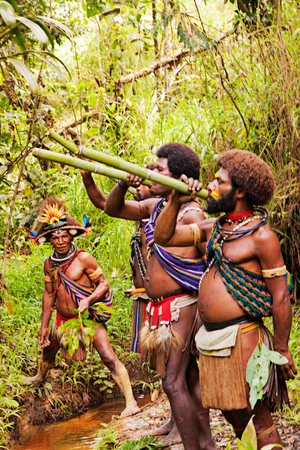It's a crisp November morning in Papua New Guinea, the second largest island nation in the world. Cliff and I have flown to Tari near the center of this land mass in a 4-seat, single-blade propeller plane. Feeling quite lucky to be alive after having braved a field landing, we're told that we'll soon be making the acquaintance of the Huli Wigmen. Who are these natives, and where do their wigs come from? I guess we'll find out in short order!
As our van makes its way up a bumpy dirt road in this remote region of the Highlands, the Wig School master comes into view. Known as Kupunu, the proprietor and teacher of the Poroiba Akua, or Wig School, greets us in full regalia. This includes a colorful headdress, replete with eye-catching feathers for which this school is famous. The tour of the Wig School is about to begin.
The Huli people are the largest ethnic group on this island, numbering between 300,000-400,000 people. Quite isolated from the rest of the world, tribal groups and clans predominate in this area. These indigenous people have populated the highlands for 1,000 years but were only discovered by accident in 1935 during the Strickland-Purari patrol.
For generations, the custom of the Huli people has been for men who have become engaged to enter the school to grow their hair. Not only do they have to meet the bride's price that is negotiable with her father, but bachelors must also posses a proper wig. Tuition for the wig school is bartered in pigs and shells. The wealth of a candidate is demonstrated by the number of pigtails that are tied to their belts and pig tusk necklaces in place.
Under Kupunu's direction, they undergo a protocol in which their hair is allowed to flourish in an unadulterated fashion for 18 months. Up to 12 times each day, the ritual they must adhere to has them drinking holy water from a stream, chanting, consecrating fern leaves in the water, and then wetting their hair with it to promote growth. Touching their hair during this 18-month period is sacrosanct so that it remains clean. Itching is avoided by the students scratching each others scalp with a bamboo sliver.
There are certain rituals to be followed by the students. A diet must be adhered to that includes certain foods such as pig's heart, pig's fat, and spicy dishes. At the end of the day when it is time to retire, they sleep in a unique position in which their necks rest on a wooden log to ensure healthy hair growth.
At the conclusion of the 18-month period, their hair is clipped and given to Napata, the hair specialist. Wigs are sewn and weaved into the final product that has several purposes. The basic concoction can be worn daily. Ceremonial wigs, however, are generated by combining 2 hairpieces in opposite directions. This eventuates in a headdress that resembles the silhouette of a bird with its wings expanded. A basic wig can command asking prices at the market of 600 Kinas (US$400). The more elaborate ceremonial hairpieces will be worn at "singsings" (festivals or major events), and can go for up to 1500 Kinas (US$900).
As we depart from the Wig School in our van, it strikes me that what we have encountered is the essence of an agrarian society. The rituals witnessed have been performed for generations. With modernization approaching, however, it remains an open question as to how long this custom can endure.




